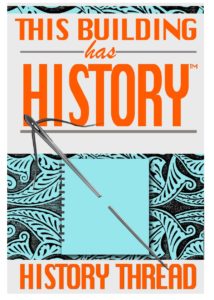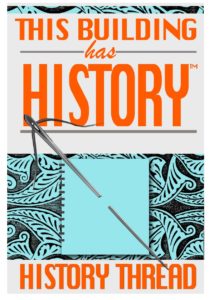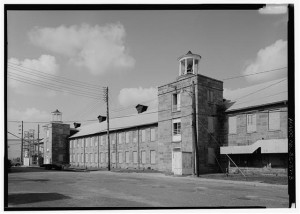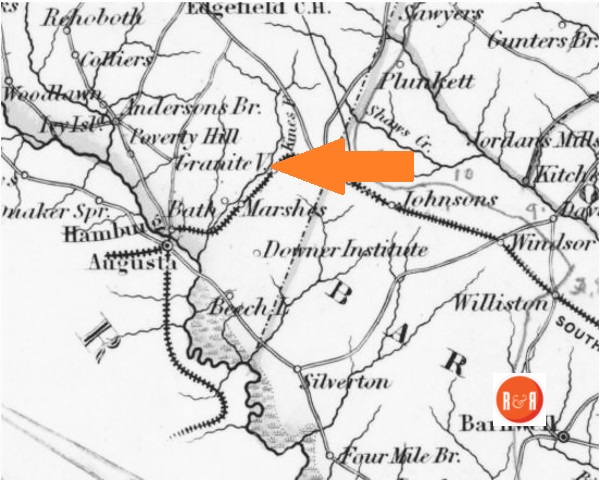City Directories and History: The re-purposed gas station at the northwest corner of Rutledge Ave. and Cannon St. was built on the former gardens of one of the grandest houses built in the “suburbs” of Charleston in the early 19th century. When the original gas station was built in the 1920s, the gas station was designated 211 Rutledge Ave., leaving the Daniel Cannon Webb House in place at 213 Rutledge Ave., slightly to the north. In 1949, when the gas station expanded, the house was demolished, and the entire parcel became known as 211 Rutledge Ave. What follows is the history of both 211 and 213 Rutledge Ave.
In the late 18th century, master builder Daniel Cannon owned an enormous swath of land between Calhoun Street and Spring Street on which he operated a wood mill known as Cannon Mills. At some point before 1788, he had some of his property platted into smaller parcels for development. On October 28, 1788, Mr. Cannon conveyed Lots 76 and 77 on the Charleston Neck to his stepdaughter’s son, Daniel Cannon Webb,[1] but because he was still a minor, the title was held by Mr. Cannon’s daughter, Martha Cannon, in trust for Mr. Webb.[2] The two lots were both 117 feet wide and ran all the way from Rutledge Ave. (then known as Pinckney Street) through the block to Ashley Ave. (then known as Thomas Street). The house at 213 Cannon Street was built on the front of Lot 76. The transfer of the two lots was recorded on November 23, 1802.
The transfer of the lots to Mr. Webb in 1802 included no reference to any buildings or other improvements to the parcels. How soon after the transfer the house was built is unclear. In the 1810 United States census, the census takers did not record street addresses; however, based on the names of his neighbors with known addresses, Mr. Webb was likely residing elsewhere, perhaps the Daniel Cannon House at 274 Calhoun Street (begun about 1802).
The first reference to Mr. Webb’s residence with more detail came only a few years later. In 1813’s city directory, Mr. Webb was identified as a factor living in Cannonborough, likely a reference to the house at 213 Rutledge Ave. A little more information came in the 1816 Charleston directory, when Mr. Webb was listed as living on the west side of the Cannon Bridge Road (as Rutledge Ave. was sometimes described). He consistently appeared in subsequent directories starting in 1819 as a resident of the corner of Cannon and Rutledge Ave. Over the years, his occupation was identified as factor and a partner in North, Webb & Co.
Daniel Cannon Webb died in 1850 and left the property to his wife, Eliza Ann Ladson Webb, for the term of her life and then to their children. His will referred to the “prudence and good judgment” in which he had “for near forty-three years, placed implicit confidence,” and he gave her the power to sell any portion.
By 1858, the house was available as an eleven room rental with furnishings and outbuildings,[3] but there is no evidence that it was ever actually rented out. During the Civil War, Mrs. Webb tried to sell the house; an ad on April 18, 1863, in the Charleston Mercury describing the house as a “commodious and elegant three and a half story HOUSE on a brick Basement, containing 12 Rooms.” The house was “finished in the best manner, and furnished with gas, grates, and bell fixings.” The house included an eight-room dependency for servants, accommodations for horses and carriages, and a flower garden.
Mrs. Webb eventually sold the house to her son William Ladson Webb,[4] a crockery and glassware merchant, for $9000 on August 26, 1867.[5] Mr. William Webb received the house but held it in trust for the benefit of his wife, Susan Winthrop Webb, and their children. During his more than thirty years of ownership, the only known image of the house was prepared. In the 1872 Bird’s Eye View of Charleston, the dwelling is shown, but with very little detailing. The image confirms a three-story house with a dependency with an area for a garden to the south of the house.
On November 27, 1900, the house was sold at a public auction as a result of a lawsuit over the title to the property. George Gadsden Creighton,[6] the president of a lumber company, bought the house for $6700.[7] The transfer was recorded on March 19, 1901. When the 1902 edition of the Sanborn Insurance maps was released, the footprint for the property showed that the house and dependency were still extant. Mr. Creighton and his wife, Hattie Creighton, occupied the house for about a decade.
Mr. Creighton sold the house on February 10, 1912, to Washington H. Zeigler, a professor at the Medical College. The deed included a covenant that no building would be built on the rear of the property that would obstruct the views from the adjacent house on Cannon Street.[8] The covenant was removed in a later deed on March 14, 1919, which adjusted the property line between the parties.[9] By at least 1920, the family began renting two apartments in the house.[10]
Although the finely built house enjoyed strong ties to a very notable Charleston family, it was no match for the arrival of gas stations. Many of the most famous houses in Charleston were built on prominent corners of major intersections where they would be the most eye-catching. Unfortunately, the same aspects that made those lots choice locations for houses also made the lots choice locations for service stations.

Courtesy of the AFLLC Collection – 2019
Mr. Zeigler sold the property in November 1922 to the Standard Oil Co. for $24,000.[11] A plat dated July 1922 showed the three-story frame house on a brick foundation with a three-story piazza; a smaller frame building with porch behind the main house; and an unidentified building (perhaps a garage) was near Cannon Street at the rear of the property. Standard Oil had already pulled a building permit in the summer of 1922 for a $5000 service station.[12] An advertisement appeared in the Evening Post on January 20, 1923, and announced the new station would open on January 24, 1923.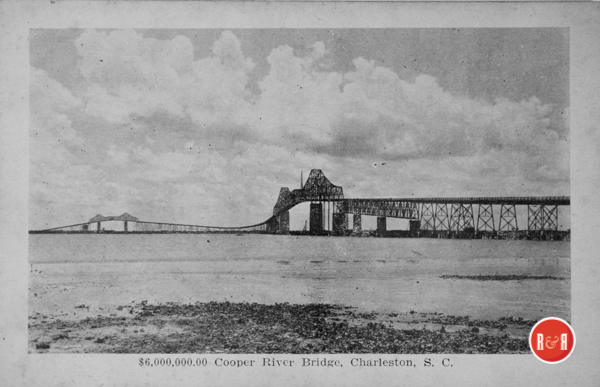
The new station seems to have been a small one located in the former garden of 213 Rutledge Ave. The station, carrying the new designation of 211 Rutledge Ave., was a single office with pumps similar to the station built at the Joseph Manigault House on Meeting Street by Standard Oil at the same time. Over the years, the Rutledge Ave. station was always associated with the Esso brand, but its name changed with different franchise operators.[13]
Meanwhile, throughout the 1920s, 1930s, and 1940s, the house itself was home to a string of renters[14] while the ground floor was converted into a grocery store. An Atlantic & Pacific grocery store opened in 1923 and remained in operation until at least 1929 when it was replaced by a Rogers Grocery.
The old house seems to have met its demise when the current gas station was constructed in 1949, expanding the size of the station to occupy the entire lot. Part of the old house, though, lives on. When the house was torn down to make space for the larger station, a salesman for Standard Oil named Hugh Wilson acquired its interior features. When he built his own house at 10 Greenhill Street, he built a very different house than 213 Rutledge Ave., but the architects at Halsey & Cummings incorporated the paneling, wainscoting, flooring, and staircase from the Rutledge Avenue house into the new dwelling.[15]
The current gas station had its grand opening on January 21, 1950 as Charlie Sanders’ Esso Servicenter. The station was a classic example of mid-century modern design with slick horizontal design including an office area with floor-to-ceiling windows and two garage bays. After a few years, the service station became Al’s Esso (1956).
Regrettably, within only a few years, the gas station that brought down the historic house closed. The station was soon retooled to serve many different purposes: N&P Pantry (a grocery) (1958), George’s Snack Bar (1958), McKenzie’s Fine Art Studio (1968-1977), Goodwill Nursery (1977), St. Joseph’s Nursery Center (1979-81), Sparkly Day Care Center (1984), and Step Ahead Clothing (1986-89).
Between the many different uses, on June 16, 1978, Isiah William Haynes bought the property for $40,000.[16] He continued renting the property out to different commercial purposes, but by the 1990s the building was vacant, and the property was used as overflow parking for a nearby parking garage.
Mr. Haynes died August 21, 1995, and the representative of his estate sold the premises to Gerard Mallon for $245,000 on May 1, 2000.[17] Mr. Mallon sold the property for $387,500 to New Cannonborough, LLC on August 30, 2002.[18]
New Cannonborough, LLC sold the station on February 28, 2011, to Petrol Holdings, LLC for $810,000.[19] The vacant gas station had a small addition made to its southern façade and a slightly larger addition to the north side in 2012, but otherwise the features of the building remained intact during a rehabilitation of the structure. The gas station took on a new life following the 2011 rehabilitation as a Caribbean restaurant named “Fuel” which remains in place today.
Stay Connected
Explore history, houses, and stories across S.C. Your membership provides you with updates on regional topics, information on historic research, preservation, and monthly feature articles. But remember R&R wants to hear from you and assist in preserving your own family genealogy and memorabilia.
Visit the Southern Queries – Forum to receive assistance in answering questions, discuss genealogy, and enjoy exploring preservation topics with other members. Also listed are several history and genealogical researchers for hire.
User comments welcome — post at the bottom of this page.
SOURCES:
[1] Mary Trusler, the widow of Thomas Doughty, married for the second time to Daniel Cannon in 1755. Among her children by her first husband was Mary “Polly” Doughty (1749-1782) who married John Webb (1744-1807) in 1769. Among the Webbs’ eight children was Daniel Cannon Webb (b. Aug. 6, 1782; d. Nov. 1850). Daniel Cannon married Eliza Ann Ladson on November 30, 1805.
[2] Deed book G7, page 431
[3] Charleston Mercury, Feb. 15, 1858, at 3
[4] William Logan Webb was born on January 19, 1821, and he died on October 24, 1901. He was married to Susan Winthrop Webb (1820-1897).
[5] Page 584
[6] (b. Sep. 27, 1870; d. Mar. 18, 1948)
[7] Deed book F23, page 273
[8] Deed book H26, page 79
[9] Deed book ___, page 667
[10] Residents included J.F. Lucas (1920), E.K. Dunham (1920), P.B. Whisnant (1921), and Joseph Benedict (1921).
[11] Deed book ___, page 549
[12] Charleston Evening Post, Aug. 21, 1922, at 3
[13] In 1936, it was known as Lee Landrum’s Esso Service Station; and Messervey’s Esso Station in 1938, Sanders’ Esso in 1948-49.
[14] Residents included H.E. Harley (1923-24), E.L. Chassereau (1923-25), V.H. Price (1925), H.J. Graham (1927), A.H. Brouthers (1928-29), Karl A. Fredrickson (1928-32), William Lasley (1930), Pate M. Murray (1932-34), L.F. Rhen (1934), Robert W. Jacques (1938-42), and Charles D. Hodge (1938-48).
[15] “Do You Know Your Charleston?” Charleston News & Courier, July 25, 1949
[16] Deed book C116, page 30
[17] Deed book L346, page 428
[18] Deed book C417, page 817
[19] Deed book 0174, page 338
[Research and written by Kevin R. Eberle, Sept. 2016]
Please enjoy this structure and all those listed in Roots and Recall. But remember each is private property. So view them from a distance or from a public area such as the sidewalk or public road.
Do you have information to share and preserve? Family, school, church, or other older photos and stories are welcome. Send them digitally through the “Share Your Story” link, so they too might be posted on Roots and Recall.
Thanks!


